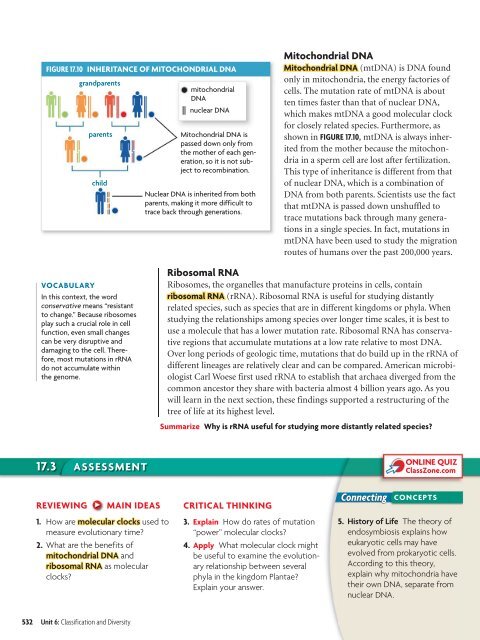Classification and Diversity
Classification and Diversity
Classification and Diversity
You also want an ePaper? Increase the reach of your titles
YUMPU automatically turns print PDFs into web optimized ePapers that Google loves.
FIGURE 17.10 INHERITANCE OF MITOCHONDRIAL DNA<br />
gr<strong>and</strong>parents<br />
parents<br />
child<br />
mitochondrial<br />
DNA<br />
nuclear DNA<br />
Mitochondrial DNA is<br />
passed down only from<br />
the mother of each generation,<br />
so it is not subject<br />
to recombination.<br />
Nuclear DNA is inherited from both<br />
parents, making it more difficult to<br />
trace back through generations.<br />
Mitochondrial DNA<br />
Mitochondrial DNA (mtDNA) is DNA found<br />
only in mitochondria, the energy factories of<br />
cells. The mutation rate of mtDNA is about<br />
ten times faster than that of nuclear DNA,<br />
which makes mtDNA a good molecular clock<br />
for closely related species. Furthermore, as<br />
shown in FIGURE 17.10, mtDNA is always inherited<br />
from the mother because the mitochondria<br />
in a sperm cell are lost after fertilization.<br />
This type of inheritance is different from that<br />
of nuclear DNA, which is a combination of<br />
DNA from both parents. Scientists use the fact<br />
that mtDNA is passed down unshuffled to<br />
trace mutations back through many generations<br />
in a single species. In fact, mutations in<br />
mtDNA have been used to study the migration<br />
routes of humans over the past 200,000 years.<br />
VOCABULARY<br />
In this context, the word<br />
conservative means “resistant<br />
to change.” Because ribosomes<br />
play such a crucial role in cell<br />
function, even small changes<br />
can be very disruptive <strong>and</strong><br />
damaging to the cell. Therefore,<br />
most mutations in rRNA<br />
do not accumulate within<br />
the genome.<br />
Ribosomal RNA<br />
Ribosomes, the organelles that manufacture proteins in cells, contain<br />
ribosomal RNA (rRNA). Ribosomal RNA is useful for studying distantly<br />
related species, such as species that are in different kingdoms or phyla. When<br />
studying the relationships among species over longer time scales, it is best to<br />
use a molecule that has a lower mutation rate. Ribosomal RNA has conservative<br />
regions that accumulate mutations at a low rate relative to most DNA.<br />
Over long periods of geologic time, mutations that do build up in the rRNA of<br />
different lineages are relatively clear <strong>and</strong> can be compared. American microbiologist<br />
Carl Woese first used rRNA to establish that archaea diverged from the<br />
common ancestor they share with bacteria almost 4 billion years ago. As you<br />
will learn in the next section, these findings supported a restructuring of the<br />
tree of life at its highest level.<br />
Summarize Why is rRNA useful for studying more distantly related species?<br />
17.3 ASSESSMENT<br />
ONLINE QUIZ<br />
ClassZone.com<br />
REVIEWING<br />
MAIN IDEAS<br />
1. How are molecular clocks used to<br />
measure evolutionary time?<br />
2. What are the benefits of<br />
mitochondrial DNA <strong>and</strong><br />
ribosomal RNA as molecular<br />
clocks?<br />
CRITICAL THINKING<br />
3. Explain How do rates of mutation<br />
“power” molecular clocks?<br />
4. Apply What molecular clock might<br />
be useful to examine the evolutionary<br />
relationship between several<br />
phyla in the kingdom Plantae?<br />
Explain your answer.<br />
Connecting CONCEPTS<br />
5. History of Life The theory of<br />
endosymbiosis explains how<br />
eukaryotic cells may have<br />
evolved from prokaryotic cells.<br />
According to this theory,<br />
explain why mitochondria have<br />
their own DNA, separate from<br />
nuclear DNA.<br />
532 Unit 6: <strong>Classification</strong> <strong>and</strong> <strong>Diversity</strong>

















